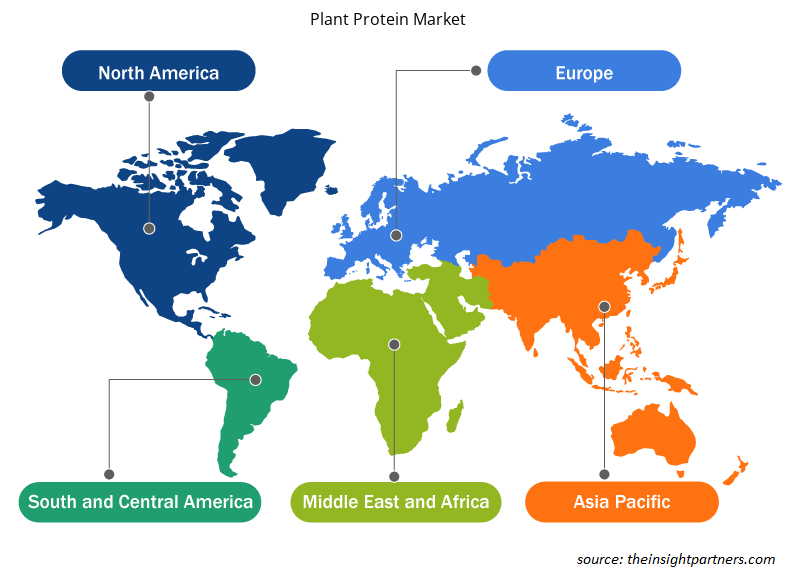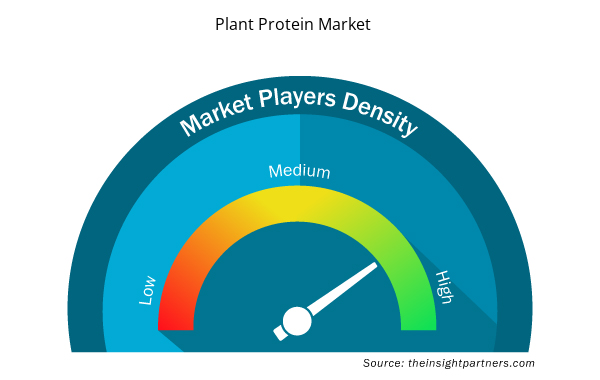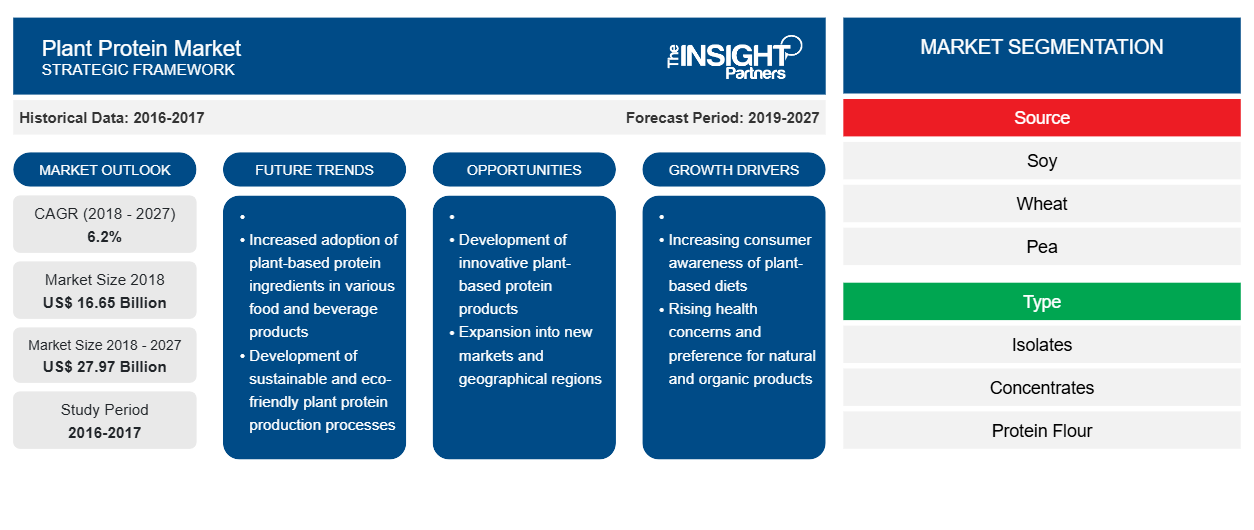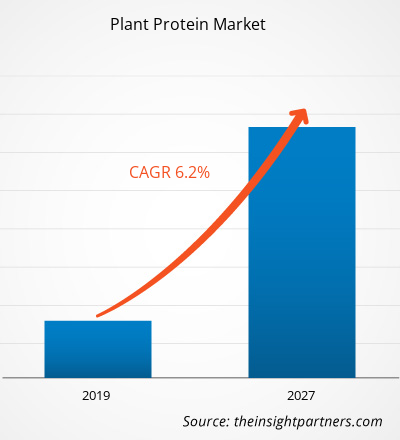2018 年植物蛋白市场价值为 166.536 亿美元,预计到 2027 年将达到 279.659 亿美元;预计 2019 年至 2027 年的复合年增长率为 6.2%。
蛋白质是人体所需的重要营养素,由氨基酸组成。植物蛋白来自各种植物来源,例如大豆、小麦、豌豆、坚果和种子等。扁豆、鹰嘴豆、花生、杏仁、螺旋藻、藜麦和奇亚籽等各种植物来源都提供大量蛋白质。由于植物蛋白热量低,因此可以作为减肥动物蛋白的替代品食用。对植物性食品的需求不断增长,加上消费者对高蛋白食品的兴趣日益浓厚,是推动全球植物蛋白市场需求增长的关键因素。
预计亚太地区的植物蛋白市场将在预测期内以最高的复合年增长率增长。该地区植物蛋白市场的增长主要归因于可支配收入的增加,生活方式的改变是亚太地区植物蛋白的主要驱动因素。中国、印度和日本等亚洲发达国家和发展中国家食品和饮料行业的快速增长为植物蛋白制造商提供了巨大的市场机会,因为它广泛应用于蛋白质饮料、乳制品替代品、肉类替代品和蛋白质棒等产品中
印度、中国和澳大利亚等发达国家和发展中国家人民的可支配收入不断提高,导致该地区对植物蛋白的需求巨大。
定制此报告以满足您的需求
您可以免费定制任何报告,包括本报告的部分内容、国家级分析、Excel 数据包,以及为初创企业和大学提供优惠和折扣
- 获取此报告的关键市场趋势。这个免费样品将包括数据分析,从市场趋势到估计和预测。
市场洞察
消费者对富含蛋白质食品的认识不断提高,推动植物蛋白市场增长
蛋白质在帮助细胞修复和保护身体免受病毒和细菌侵害方面发挥着重要作用,在将分子输送到全身的过程中起着关键作用。它还能促进儿童、青少年和孕妇的正常生长发育。
多项研究表明,富含蛋白质的饮食有助于在体重管理或减肥计划期间增加肌肉质量和力量,并防止肌肉流失。
摄入更多蛋白质的人往往能更好地保持骨量,患骨质疏松症和骨折的风险也大大降低。高蛋白质摄入量可促进新陈代谢,从而燃烧大量卡路里。这进一步有助于适当的体重管理和减肥。蛋白质的这些好处吸引着消费者购买市场上富含蛋白质的食品和饮料。这进一步创造了全球对植物蛋白的巨大需求。
富含蛋白质的食品被认为是食品和饮料行业最强劲的趋势之一。随着食品中蛋白质的趋势,食品和饮料制造商正在尝试生产营养食品。消费者对通过食用富含蛋白质的食物来实现减肥、抗衰老和其他健康相关问题的有效方法的认识不断提高,这推动了对植物蛋白的需求。此外,健康和保健趋势的不断增长在过去几年中显著促进了对功能性和强化食品和饮料的强劲需求。因此,消费者对富含蛋白质的食物的认识不断提高,预计将推动植物蛋白市场的增长
基于来源的洞察
根据来源,植物蛋白市场分为大豆、小麦、豌豆和其他。大豆部分在 2018 年占据了最大的市场份额;然而,豌豆部分预计将在预测期内实现最高的复合年增长率。大豆分离蛋白是一种高度精制的大豆蛋白,蛋白质含量至少为 90%。它由脱脂大豆粉制成,其中大部分非蛋白质成分(包括脂肪和碳水化合物)都被去除。大豆蛋白粉由脱脂大豆片制成,用酒精或水清洗以去除糖和膳食纤维。然后将它们脱水并磨成粉末。大豆蛋白粉用于制作婴儿大豆配方奶粉,以及各种肉类和乳制品替代品。大豆浓缩蛋白通常含有 70% 的大豆蛋白,基本上是不含水溶性碳水化合物的脱脂大豆粉。这种形式的蛋白质是通过从脱壳和脱脂大豆中去除部分碳水化合物制成的。豆粉是将大豆磨成细粉制成的。
基于类型的洞察
根据类型,植物蛋白市场分为分离物、浓缩物和蛋白粉。浓缩物部分在 2018 年占据了最大的市场份额。植物蛋白浓缩物是通过从大豆、小麦、豌豆、藜麦、燕麦、豆类和坚果等各种来源提取蛋白质而制成的。这些通常提供 60-80% 的蛋白质,其余 20-40% 由脂肪和碳水化合物组成。浓缩植物蛋白是加工程度最低的蛋白粉。浓缩形式的植物蛋白有助于肌肉在剧烈运动后快速恢复,因为它能被身体快速吸收。因此,植物蛋白浓缩物的易得性加上与植物蛋白分离物相比更低的价格是推动市场发展的关键因素。植物蛋白浓缩物往往是最便宜的选择,但与植物蛋白分离物相比,它们提供的蛋白质最少,因为它们含有更多的其他成分。这些额外的成分可能包括脂肪、胆固醇、乳糖和麸质。试图限制脂肪摄入量或消化系统敏感的消费者应避免使用植物蛋白浓缩物。
基于应用的洞察
根据类型,植物蛋白市场细分为蛋白饮料、乳制品替代品、肉类替代品和肉类填充剂、蛋白棒、烘焙食品和其他应用。肉类替代品和肉类填充剂部分在 2018 年占据了最大的市场份额。肉类替代品包括豆腐、豆豉、组织化植物蛋白、面筋和 Quorn 等。这些产品的味道、外观和质地与家禽、肉类和鱼类产品相似。它们使用谷物和植物成分制造,以取代动物蛋白和矿物质(特别是钙),有助于降低胆固醇水平、预防更年期困难和其他相关疾病。植物蛋白广泛用于肉类替代品的生产。豆类和豆科植物是价格实惠的植物蛋白来源,可作为肉类替代品。大豆也是生产肉类替代品的主要来源之一。豌豆蛋白分离物主要由肉类替代品制造商使用,例如 Daiya、Gardein、Ben & Jerry's、Beyond Meat、Just Mayo 和 Ripple Foods 等。因此,肉类替代品的需求和产量激增导致对植物蛋白的需求增加。由于消费者对健康的日益关注和对素食的日益偏好,对肉类替代品的需求正在增加。此外,由于食用肉类和肉类产品导致肥胖水平上升,导致消费者对肉类替代品的偏好日益增加。
植物蛋白市场中的少数参与者包括阿彻丹尼尔斯米德兰公司 (Archer Daniels Midland Company)、Axiom Foods, Inc.、Burcon NutraScience Corporation、嘉吉公司 (Cargill, Incorporated)、杜邦公司 (EI Du Pont De Nemours and Company)、Glanbia plc、Ingredion Incorporated、凯瑞集团 (Kerry Group)、荷兰皇家帝斯曼公司 (Koninklijke DSM NV) 和罗盖特公司 (Roquette Frères)。主要公司实施并购和研发战略,以扩大客户群并在全球市场中获得显著份额,这也使他们能够在全球范围内保持自己的品牌名称。
植物蛋白市场区域洞察
Insight Partners 的分析师详细解释了预测期内影响植物蛋白市场的区域趋势和因素。本节还讨论了北美、欧洲、亚太地区、中东和非洲以及南美和中美洲的植物蛋白市场细分和地理位置。

- 获取植物蛋白市场的区域特定数据
植物蛋白市场报告范围
| 报告属性 | 细节 |
|---|---|
| 2018 年市场规模 | 166.5亿美元 |
| 2027 年市场规模 | 279.7 亿美元 |
| 全球复合年增长率(2018 - 2027) | 6.2% |
| 史料 | 2016-2017 |
| 预测期 | 2019-2027 |
| 涵盖的领域 | 按来源
|
| 覆盖地区和国家 | 北美
|
| 市场领导者和主要公司简介 |
|
植物蛋白市场参与者密度:了解其对业务动态的影响
植物蛋白市场正在快速增长,这得益于终端用户需求的不断增长,而这些需求又源于消费者偏好的不断变化、技术进步以及对产品优势的认识不断提高等因素。随着需求的增加,企业正在扩大其产品范围,进行创新以满足消费者的需求,并利用新兴趋势,从而进一步推动市场增长。
市场参与者密度是指在特定市场或行业内运营的企业或公司的分布情况。它表明在给定市场空间中,相对于其规模或总市场价值,有多少竞争对手(市场参与者)存在。
在植物蛋白市场运营的主要公司有:
- 宜瑞安公司
- 阿彻丹尼尔斯米德兰公司
- Axiom Foods, Inc.
- Burcon 营养科学公司
- 嘉吉公司
免责声明:上面列出的公司没有按照任何特定顺序排列。

- 了解植物蛋白市场顶级关键参与者概况
报告亮点
- 植物蛋白市场的渐进式行业趋势可帮助参与者制定有效的长期战略
- 发达市场和发展中市场采用的业务增长战略
- 2018 年至 2027 年植物蛋白市场定量分析
- 全球植物蛋白需求量估计
- PEST 分析可说明行业内买家和供应商的效率
- 了解竞争市场状况的最新发展
- 市场趋势和前景以及推动和抑制植物蛋白市场增长的因素
- 通过强调支撑商业利益的市场策略来协助决策过程,从而促进市场增长
- 不同节点植物蛋白市场规模
- 市场的详细概述和细分,以及植物蛋白行业动态
- 各地区植物蛋白市场规模及增长潜力
- 历史分析(2 年)、基准年、预测(7 年)及复合年增长率
- PEST 和 SWOT 分析
- 市场规模价值/数量 - 全球、区域、国家
- 行业和竞争格局
- Excel 数据集



Report Coverage
Revenue forecast, Company Analysis, Industry landscape, Growth factors, and Trends

Segment Covered
This text is related
to segments covered.

Regional Scope
North America, Europe, Asia Pacific, Middle East & Africa, South & Central America

Country Scope
This text is related
to country scope.
常见问题
The major reason that are driving the global plant protein market are as follows: Health benefits associated with plant protein consumption: Plant-based diets are rich in nutrients like protein, magnesium, potassium, and vitamins K and C, which can improve muscle and bone health in people of all ages. Also, plant protein contains sulfur amino acids and tryptophan. These nutrients helps the body to make proteins and certain brain-signaling chemicals.
Rising consumer awareness about protein-rich food: Proteins are building blocks to maintain the structure and functions of the human body. Proteins are made up of amino acids that are attached by peptide bonds in long chains. There are 20 different kinds of amino acids linked together that determines the role of protein in the human body. Proteins play a key role in transporting molecules throughout the body by helping in cell repair and protecting the body from viruses and bacteria. It also promotes proper growth and development in children, teenagers, and pregnant women.
Global plant protein’s concentrates segment is expected to grow by a good market share. Based on type, the plant protein market is categorized into isolates, concentrates, and protein flour. These forms of plant protein are extensively used in the food and beverage industry to enhance the nutritional content of the food. The market for all the three types of plant protein is driven by various factors such as rising awareness about protein-rich diets and consumer shift towards a vegan diet globally. The high nutritional content of plant protein has exacerbated its adoption trend. The concentrates segment dominated the global plant protein market and is expected to register an exceptional growth rate during the forecast period.
The plant protein market was dominated by North America at a global level. North America comprises developed and developing countries such as the US, Canada, and Mexico. North America is likely to account for a remarkable share of the plant protein market during the forecast period. Consumers in the US and Canada are shifting their preferences toward a healthy lifestyle and prefer products that provide health benefits. While most people in North America are becoming physically active, obesity still exists as a major concern, leading to chronic cardiovascular diseases (CVD), high blood pressure, and cholesterol among masses.
Trends and growth analysis reports related to Food and Beverages : READ MORE..
The List of Companies - Plant Protein Market
- Ingredion Incorporated
- Archer Daniels Midland Company
- Axiom Foods, Inc.
- Burcon NutraScience Corporation
- Cargill, Incorporated
- E. I. Du Pont De Nemours and Company
- Glanbia plc
- Kerry Group
- Koninklijke DSM N.V.
- Roquette Frères
The Insight Partners performs research in 4 major stages: Data Collection & Secondary Research, Primary Research, Data Analysis and Data Triangulation & Final Review.
- Data Collection and Secondary Research:
As a market research and consulting firm operating from a decade, we have published and advised several client across the globe. First step for any study will start with an assessment of currently available data and insights from existing reports. Further, historical and current market information is collected from Investor Presentations, Annual Reports, SEC Filings, etc., and other information related to company’s performance and market positioning are gathered from Paid Databases (Factiva, Hoovers, and Reuters) and various other publications available in public domain.
Several associations trade associates, technical forums, institutes, societies and organization are accessed to gain technical as well as market related insights through their publications such as research papers, blogs and press releases related to the studies are referred to get cues about the market. Further, white papers, journals, magazines, and other news articles published in last 3 years are scrutinized and analyzed to understand the current market trends.
- Primary Research:
The primarily interview analysis comprise of data obtained from industry participants interview and answers to survey questions gathered by in-house primary team.
For primary research, interviews are conducted with industry experts/CEOs/Marketing Managers/VPs/Subject Matter Experts from both demand and supply side to get a 360-degree view of the market. The primary team conducts several interviews based on the complexity of the markets to understand the various market trends and dynamics which makes research more credible and precise.
A typical research interview fulfils the following functions:
- Provides first-hand information on the market size, market trends, growth trends, competitive landscape, and outlook
- Validates and strengthens in-house secondary research findings
- Develops the analysis team’s expertise and market understanding
Primary research involves email interactions and telephone interviews for each market, category, segment, and sub-segment across geographies. The participants who typically take part in such a process include, but are not limited to:
- Industry participants: VPs, business development managers, market intelligence managers and national sales managers
- Outside experts: Valuation experts, research analysts and key opinion leaders specializing in the electronics and semiconductor industry.
Below is the breakup of our primary respondents by company, designation, and region:

Once we receive the confirmation from primary research sources or primary respondents, we finalize the base year market estimation and forecast the data as per the macroeconomic and microeconomic factors assessed during data collection.
- Data Analysis:
Once data is validated through both secondary as well as primary respondents, we finalize the market estimations by hypothesis formulation and factor analysis at regional and country level.
- Macro-Economic Factor Analysis:
We analyse macroeconomic indicators such the gross domestic product (GDP), increase in the demand for goods and services across industries, technological advancement, regional economic growth, governmental policies, the influence of COVID-19, PEST analysis, and other aspects. This analysis aids in setting benchmarks for various nations/regions and approximating market splits. Additionally, the general trend of the aforementioned components aid in determining the market's development possibilities.
- Country Level Data:
Various factors that are especially aligned to the country are taken into account to determine the market size for a certain area and country, including the presence of vendors, such as headquarters and offices, the country's GDP, demand patterns, and industry growth. To comprehend the market dynamics for the nation, a number of growth variables, inhibitors, application areas, and current market trends are researched. The aforementioned elements aid in determining the country's overall market's growth potential.
- Company Profile:
The “Table of Contents” is formulated by listing and analyzing more than 25 - 30 companies operating in the market ecosystem across geographies. However, we profile only 10 companies as a standard practice in our syndicate reports. These 10 companies comprise leading, emerging, and regional players. Nonetheless, our analysis is not restricted to the 10 listed companies, we also analyze other companies present in the market to develop a holistic view and understand the prevailing trends. The “Company Profiles” section in the report covers key facts, business description, products & services, financial information, SWOT analysis, and key developments. The financial information presented is extracted from the annual reports and official documents of the publicly listed companies. Upon collecting the information for the sections of respective companies, we verify them via various primary sources and then compile the data in respective company profiles. The company level information helps us in deriving the base number as well as in forecasting the market size.
- Developing Base Number:
Aggregation of sales statistics (2020-2022) and macro-economic factor, and other secondary and primary research insights are utilized to arrive at base number and related market shares for 2022. The data gaps are identified in this step and relevant market data is analyzed, collected from paid primary interviews or databases. On finalizing the base year market size, forecasts are developed on the basis of macro-economic, industry and market growth factors and company level analysis.
- Data Triangulation and Final Review:
The market findings and base year market size calculations are validated from supply as well as demand side. Demand side validations are based on macro-economic factor analysis and benchmarks for respective regions and countries. In case of supply side validations, revenues of major companies are estimated (in case not available) based on industry benchmark, approximate number of employees, product portfolio, and primary interviews revenues are gathered. Further revenue from target product/service segment is assessed to avoid overshooting of market statistics. In case of heavy deviations between supply and demand side values, all thes steps are repeated to achieve synchronization.
We follow an iterative model, wherein we share our research findings with Subject Matter Experts (SME’s) and Key Opinion Leaders (KOLs) until consensus view of the market is not formulated – this model negates any drastic deviation in the opinions of experts. Only validated and universally acceptable research findings are quoted in our reports.
We have important check points that we use to validate our research findings – which we call – data triangulation, where we validate the information, we generate from secondary sources with primary interviews and then we re-validate with our internal data bases and Subject matter experts. This comprehensive model enables us to deliver high quality, reliable data in shortest possible time.


 获取此报告的免费样本
获取此报告的免费样本